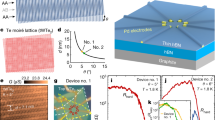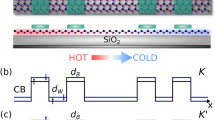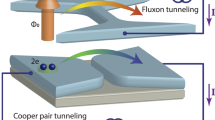Abstract
Metallic nanowires are of great interest as interconnects in nanoelectronic devices1. They also represent important systems for understanding the complexity of electronic interactions and conductivity in one dimension2. We have fabricated exceptionally long and uniform YSi2 nanowires through self-assembly of yttrium atoms on Si(001). The wire widths are quantized in odd multiples of the Si substrate lattice constant. The thinnest wires represent one of the closest realizations of the isolated Peierls chain3, exhibiting van Hove type singularities in the one-dimensional density of states and charge-order fluctuations below 150 K. The structure of the wire was determined through a detailed comparison of scanning tunnelling microscopy data and first-principles calculations. Quantized width variations along the thinnest wires produce built-in Schottky junctions, the electronic properties of which are governed by the finite size and temperature scaling of the charge-ordering correlation. This illustrates how a collective phenomenon such as charge ordering might be exploited in nanoelectronic devices.
This is a preview of subscription content, access via your institution
Access options
Subscribe to this journal
Receive 12 print issues and online access
$259.00 per year
only $21.58 per issue
Buy this article
- Purchase on Springer Link
- Instant access to full article PDF
Prices may be subject to local taxes which are calculated during checkout




Similar content being viewed by others
References
Barth, J. V., Costantini, G. & Kern, K. Engineering atomic and molecular nanostructures at surfaces. Nature 437, 671–679 (2005).
Giamarchi, T. Quantum Physics in One Dimension (Oxford Univ. Press, New York, 2004).
Peierls, R. E. Quantum Theory of Solids (Oxford Univ. Press, Oxford, 1955).
Grüner, G. Density Waves in Solids 1 edn (Addison–Wesley, Reading, MA, 1994).
Berlinsky, A. J. One-dimensional metals and charge density wave effects in these materials. Rep. Prog. Phys. 42, 1243–1283 (1979).
Charlier, J. C., Blase, X. & Roche, S. Electronic and transport properties of nanotubes. Rev. Mod. Phys. 79, 677–732 (2007).
Connétable, D., Rignanese, G.-M., Charlier, J.-C. & Blase, X. Room temperature Peierls distortion in small diameter nanotubes. Phys. Rev. Lett. 94, 015503 (2005).
Barnett, R., Demler, E. & Kaxiras, E. Electron–phonon interaction in ultrasmall-radius carbon nanotubes. Phys. Rev. B 71, 035429 (2005).
Piscanec, S., Lazzeri, M., Robertson, J., Ferrari, A. C. & Mauri, F. Optical phonons in carbon nanotubes: Kohn anomalies, Peierls distortions, and dynamic effects. Phys. Rev. B 75, 035427 (2007).
Farhat, H. et al. Phonon softening in individual metallic carbon nanotubes due to the Kohn anomaly. Phys. Rev. Lett. 99, 145506 (2007).
Liu, B. Z. & Nogami, J. An STM study of the Si(001)(2×7)-Gd, Dy surface. Surf. Sci. 540, 136–144 (2003).
Preinesberger, C., Vandré, S., Kalka, T. & Dähne-Prietsch, M. Formation of dysprosium silicide wires on Si(001). J. Phys. D: Appl. Phys. 31, L43–L45 (1998).
Chen, Y., Ohlberg, D. A. A., Medeiros-Ribeiro, G., Chang, Y. A. & Williams, R. S. Self-assembled growth of epitaxial erbium disilicide nanowires on silicon (001). Appl. Phys. Lett. 76, 4004–4006 (2000).
Chen, Y., Ohlberg, D. A. A. & Williams, R. S. Nanowires of four epitaxial hexagonal silicides grown on Si(001). J. Appl. Phys. 91, 3213–3218 (2002).
Preinesberger, C., Becker, S. K., Vandré, S., Kalka, T. & Dähne, M. Structure of DySi2 nanowires on Si(001). J. Appl. Phys. 91, 1695–1697 (2002).
Liu, B. Z. & Nogami, J. A scanning tunneling microscopy study of dysprosium silicide nanowire growth on Si(001). J. Appl. Phys. 93, 593–599 (2003).
Pradhan, A., Ma, N.-Y. & Liu, F. Theory of equilibrium shape of an anisotropically strained island: Thermodynamic limits for growth of nanowires. Phys. Rev. B 70, 193405 (2004).
Blöchl, P. E. Projector augmented-wave method. Phys. Rev. B 50, 17953–17979 (1994).
Kresse, G. & Joubert, J. From ultrasoft pseudopotentials to the projector augmented-wave method. Phys. Rev. B 59, 1758–1775 (1999).
Wildöer, J. W. G., Venema, L. C., Rinzler, A. G., Smalley, R. E. & Dekker, C. Electronic structure of atomically resolved carbon nanotubes. Nature 391, 59–62 (1998).
Kim, P., Odom, T. W., Huang, J. & Lieber, C. M. Electronic density of states of atomically resolved single-walled carbon nanotubes: Van Hove singularities and end states. Phys. Rev. Lett. 82, 1225–1228 (1999).
Venkataraman, L. & Lieber, C. M. Molybdenum selenide molecular wires as one-dimensional conductors. Phys. Rev. Lett. 83, 5334–5337 (1999).
Carpinelli, J. M., Weitering, H. H., Plummer, E. W. & Stumpf, R. Direct observation of a surface charge density wave. Nature 381, 398–400 (1996).
Urban, D. F., Stafford, C. A. & Grabert, H. Scaling theory of the Peierls charge density wave in metal nanowires. Phys. Rev. B 75, 205428 (2007).
Aruga, T. Surface Peierls transition on Cu(001) covered with heavier p-block metals. Surf. Sci. Rep. 61, 283–302 (2006).
Acknowledgements
We thank Z.Y. Zhang and G.M. Stocks for stimulating discussions. The experimental research was sponsored by NIH Grant No. R01HG002647, NSF Grant No. DMR0606485 and by the Center for Nanophase Materials Sciences at Oak Ridge National Laboratory, which is sponsored by the Division of Scientific User Facilities, US Department of Energy. The computational research involved resources from the National Energy Research Scientific Computing Center, which is supported by the Office of Science of the US Department of Energy under Contract No. DE-AC02-05CH11231, and from the National Center for Computational Sciences at Oak Ridge National Laboratory, which is supported by the Office of Science of the US Department of Energy under Contract DE-AC05-00OR22725.
Author information
Authors and Affiliations
Corresponding author
Supplementary information
Supplementary Information
Discussion and Figure S1–S2 (PDF 171 kb)
Rights and permissions
About this article
Cite this article
Zeng, C., Kent, P., Kim, TH. et al. Charge-order fluctuations in one-dimensional silicides. Nature Mater 7, 539–542 (2008). https://doi.org/10.1038/nmat2209
Received:
Accepted:
Published:
Issue Date:
DOI: https://doi.org/10.1038/nmat2209
This article is cited by
-
A tunable and unidirectional one-dimensional electronic system Nb2n+1SinTe4n+2
npj Quantum Materials (2020)
-
Atomic structures of self-assembled epitaxially grown GdSi2 nanowires on Si(001) by STM
Scientific Reports (2019)



